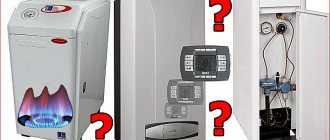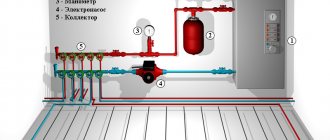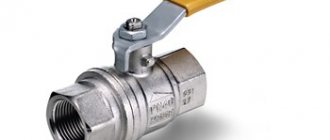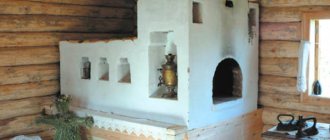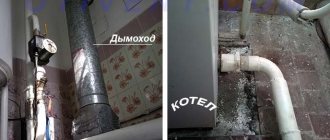Here you will learn:
- Types of heating
- Alternative heating for a cottage or private house
- Pros and cons of different types of coolants
- What is the most profitable heating system in a cottage?
- Comparison of costs of different heating systems
- One- and two-pipe heating systems
- Basic elements of a water heating system
- Which heating radiators to choose
- Installation of a cottage heating system
Regardless of whether an old system is being modernized or it is being designed from scratch in a newly built house, the first thing to start with is becoming familiar with the regulatory documentation. It describes in detail how the equipment is put into operation and describes the subtleties and features of its further use.
After spending some time on this, you can be sure that the heating system will last for many years. From year to year, the requirements are adjusted and updated. But there are some principles that every cottage owner should know. The first thing that needs to be ensured when installing a heating system is explosion and fire safety.
For safe operation during the installation process, you need to ensure free access to the equipment for cleaning and regular checks.
The list of rules that will help make a private home not only cozy, but also safe to live in, should include the following aspects:
- The temperature of open heating system elements should not be higher than that recommended by the manufacturer.
- Equipment and all appliances should be properly insulated. This will avoid burns, eliminate the formation of moisture and reduce heat loss. In addition, hot elements can ignite dust, gas or aerosol in the room.
- When using a coolant, the temperature of the latter must be 20 degrees Celsius lower than its evaporation or self-ignition temperature. For example, if the system uses water, then it must be prevented from boiling. An excellent solution would be to raise the pressure.
There are also operational requirements for the heating system. After all, any equipment must be as strong, durable, easy to operate, silent and easy to repair as possible.
It is better to order equipment from trusted manufacturers. Such companies produce truly high-quality products, since they stand behind them with their own name.
By choosing a boiler, radiators and pipes that best meet the listed criteria, you can save yourself from many problems.
Types of heating
There are two types of heating of country houses: autonomous and centralized heating. They are divided into several subspecies, operating on different energy sources:
- Natural gas.
- Liquid fuel – gasoline, diesel, diesel oil.
- Solid fuel - firewood, pellets, coal.
- Electricity.
- Natural sources of energy.
Each of them has its own set of advantages that are beneficial to use under certain conditions.
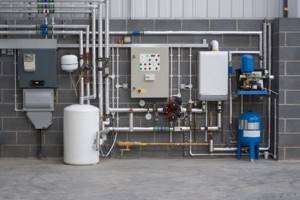
Heating equipment for a country house
Gas is a source of thermal energy
This type of heating is the most effective today. Gas is a cheap source of energy. It is available to all categories of citizens. Perhaps someone thinks that the most environmentally friendly type of fuel is wood. This is wrong. The most harmless gas for the atmosphere is gas. In addition, this type of heating has excellent efficiency, which suggests that it is used more efficiently than other fuel options.

Gas heating system diagram.
There are also negative aspects. Gas pipelines do not run everywhere. Their proximity is a prerequisite for those whose choice fell on this type of heating. Residents of remote areas do not have the opportunity to supply gas to themselves.
It should be noted that this type of thermal energy is highly toxic. Its leakage could have fatal consequences. In addition, the gas is explosive.
However, careless handling can cause trouble in cases with other heat sources.
Alternative heating for a cottage or private house
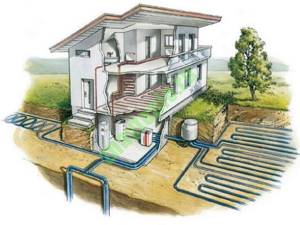
Heat pumps or solar collectors are most often used as alternative sources of thermal energy. The latter can also be a source of electricity. The cost of such equipment at the moment is astronomical and only owners of large, very large residential properties, where such investments will pay off in the foreseeable future, can afford them. In developed countries, governments actively subsidize the use of such equipment. Well, in the former USSR, the use of heat pumps and solar collectors turns out to be much more expensive than gas, coal and even electricity.
Additional home heating options
Solar thermal collectors

The upward trend in energy prices is forcing us to look for alternative heat sources. One of the popular non-traditional types of energy production is solar collectors. They are mounted on the roof and included in a heating system equipped with a boiler. Control over the supply of solar energy and regulation of the supply of energy to the boiler to maintain the set temperature is carried out using automation. The cost of such devices is quite high.
Wind generators
Using a wind generator for heating a country house is advisable in combination with a diesel generator and battery. In this case, the wind-diesel complex works as follows: the battery is charged from wind energy, which is the source of electricity in the house. During periods when there is no wind, the energy in the battery is consumed up to a certain point. With its onset, the diesel generator starts up, which prevents power outages.
When an air flow occurs, the diesel generator stops working and the battery begins to receive a charge from the wind generator.
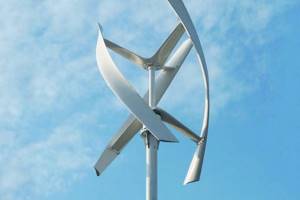
Wind energy for heating
Before deciding to install a wind generator, you should consider the following:
- Equipment of this kind has a significant cost.
- Absolutely dependent on the weather.
- The cost of installation increases due to the purchase of expensive batteries.
- If repair work is necessary, its price will also be significant.
- All of these factors lead to an overall increase in the cost of electricity.
The presence of negative aspects does not lead to a complete denial of the profitability of using a wind generator. In addition to reducing the cost of equipment, heating a home using it will increase the profitability rate. The reasons for this are the following:
- The use of low quality electricity will not affect the operation of electric heaters and will make it possible to use equipment at a lower cost.
- You can abandon batteries and use a boiler, that is, an ordinary container containing coolant, to store energy.
- The ability to temporarily maintain temperature conditions over a wide range without consuming electrical energy.
Pros and cons of different types of coolants
Depending on the coolant, heating can be water, air, or electric. Some cottages are heated using open flames - fireplaces or stoves. Each type of coolant has its own advantages and disadvantages:
Water systems consist of a boiler, pipes and radiators. The cold coolant is heated in the boiler, then flows through pipes into radiators, where it gives off heat to the surrounding air. The cooled water is fed into the boiler and the cycle repeats again.
If the system is combined with underfloor heating, then the coolant flows from the radiators into the second circuit and only then returns to the heating device. The boiler itself can operate on gas, electricity, solid or liquid fuel.
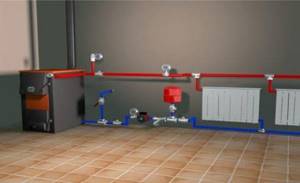
Water heating with radiators
The principle of operation of the air system is simple: cold air enters the heat generator, from where it is supplied through air ducts to the rooms of the cottage. Warm flows displace cold ones, which also enter the heat generator, and the cycle repeats.
The air circulation mode can be natural or forced. In the first case, the heating in the cottage is disrupted if the windows or doors are open. And in the second you have to use electric fans.
To heat the cottage, you can use convectors, heaters or any type of electric heated floor (cable, carbon, etc.). These systems are the easiest to maintain because they are usually fully automated.
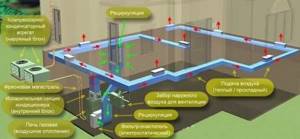
Scheme of air heating with a gas furnace
Electric heating of a cottage will cost much more than other types of heating. Another disadvantage: in the event of an accident, the house may be left without electricity and heating at the same time.
A stove or fireplace may be a good option for a small space, but it is unlikely to be suitable for a house with several rooms. In addition, you will have to give up the idea of organizing a convenient hot water system.
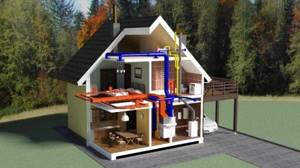
Autonomous heating of a private house
Air heating
The air heating system consists of a heat generator and a water heater responsible for heating the air. Thanks to the fan and distribution heads, air masses are distributed throughout the house.
Characteristics
The advantages of an air heating system are: high efficiency (93%), the ability to warm up a room in the shortest possible time, and maintaining an optimal temperature. Also, a heating system with an air intake can be equipped with air ionizers or cleaning filters.
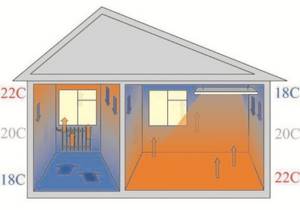
The disadvantages of air heating include the following:
- an air heating system can only be installed during the construction of a house;
- regular maintenance is required;
- high demand for electricity (an additional source of power supply will be required);
- Air filters need to be changed frequently;
- high installation and maintenance costs;
- drawing in dust from the street (applies only to a forced draft system).
The air heating system can use gas or diesel fuel. The calculation of fuel consumption is similar to example No. 1.
What is the most profitable heating system in a cottage?
If it is possible to connect to a gas main, this is an ideal option. Water heating in a cottage from a gas boiler was and remains the most profitable. It is best to use radiators as heating devices.
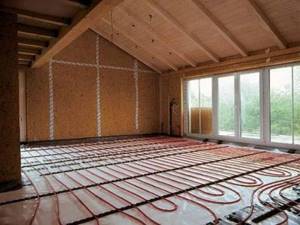
Warm floor in a cottage
An alternative to traditional batteries is water heated floors. However, in regions with harsh climates, underfloor heating alone will not be enough. You can choose a combined option: radiators and heated floors.
In the absence of gas, you have to choose which energy source is the cheapest. It can be electricity, solid or liquid fuel. When making calculations, they are guided by the area and number of floors of the cottage. The type of building materials and thermal insulation features are also important.
For a comfortable stay, you need to take care of the hot water supply. It often makes sense to connect a double-circuit boiler, which will provide both heating and the required volume of hot water.
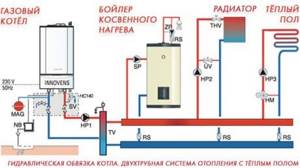
Scheme of combined heating and hot water supply
Autonomous electric heating options
The operation of an individual heating system using electricity is possible in two options: direct and indirect. The choice of one or the other should be based on the characteristics of each.
Electric heating direct heating
With direct heating, electrical energy will be directly converted into heat. There are several systems that can be installed in an apartment.
- Installation of radiators or convectors. The first are devices that operate on mineral oil. Their operation can be controlled by an installed temperature controller. Some models are equipped with automatic control. The advantages of heating radiators are fast heating, which allows you to heat the room in a fairly short time. They can also be installed in any place where there is an electrical supply. Unlike radiators, convectors operate on air heated by built-in heating elements. Such devices can be mounted both on the wall and on the floor.
- "Warm floor". It consists of special mats or cables laid under the floor covering or screed. When turned on, the entire floor area is heated, which allows heat to spread more evenly. The system is equipped with sensors that monitor the temperature in the room. As soon as the temperature rises to the set temperature, the heating automatically turns off and, conversely, when the temperature drops, the system turns on the heating. It is also possible to set your own heat level in different rooms. The advantages of “warm floors” are their safety, fast heating and easy installation into any floor base. One of the disadvantages is the high energy consumption, so it is recommended to use such a heating system as an additional one.
- Infrared heating. It is a surface assembled from a special film with graphite paste that is laid on the floor or ceiling. When current passes through the paste, infrared radiation appears. The rays move until they encounter an insurmountable obstacle in the form of furniture, floor or ceiling. They linger and begin to heat the object blocking their path. Once warmed up, the floor or ceiling releases heat into the air and the temperature in the room quickly rises. The main advantage of infrared heating is the most comfortable temperature distribution for a person, in which the bottom of the room will always be warmer than the top. The system has built-in temperature control sensors that can turn the heating on and off as needed. The film is installed into the floor or ceiling and does not spoil the appearance of the room at all.
- Water electric heating. It is a closed circuit in which the coolant is heated by an electric boiler. The efficiency of the system depends on the type of boiler used. The most common option is with a heating element, when tubular electric heaters are used to operate the equipment. The disadvantage of these is low efficiency and high power consumption. There are also electrode boilers. Their electricity consumption is the same, but they will last much longer than heating elements.
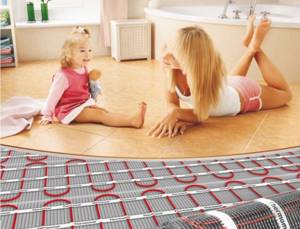
You can buy heating equipment that runs on electricity either as the main one or in addition to a gas or solid fuel boiler.
Electric heating indirect heating
It is a pumping thermal equipment of various types. Electricity in such systems is consumed only to maintain the operation of the pump, which accumulates heat from the air masses in the room. It is better to use this heating option in areas where there are no severe frosts and the temperature regime is relatively stable.
To heat the apartment, air-to-air or air-to-water pumps are used. The former are similar in functionality to air conditioners, so they can be used in summer to cool indoor air. The disadvantage of indirect heating is the high cost of equipment and installation, but in the future it will pay for itself.
Comparison of costs of different heating systems
Often, the choice of a specific heating system is based on the starting cost of the equipment and its subsequent installation. Based on this indicator, we obtain the following data:
- Electricity. Initial investments up to 20,000 rubles.
- Solid fuel. Purchasing equipment will require from 15 to 25 thousand rubles.
- Liquid fuel boilers. Installation will cost 40-50 thousand.
- Gas heating with own storage. Price 100-120 thousand rubles.
- Centralized gas main. Due to the high cost of communication and connection, the cost exceeds 300,000 rubles.
Use of solid fuels
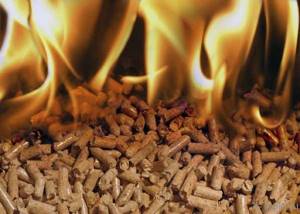
As you may have guessed, we are talking about the use of coal, wood, pellets and peat. These energy sources are cheap. They are not in short supply, so you can always stock up for the winter. Boiler houses running on solid fuel are not uncommon in our latitudes.
The disadvantage is that you will have to allocate quite a lot of space to store this fuel. As a rule, a separate building is used. In addition, the combustion system must be cleaned periodically. In other words, operation is possible only with constant maintenance of such equipment. Not the most convenient option.
One- and two-pipe heating systems
In a single-pipe water heating system for a cottage, the circulation of coolant from the boiler and back is carried out along one line, which simultaneously plays the role of both supply and return. The whole scheme eventually closes into one large ring encircling the building. And to this ring, along the entire length of the pipe, the installation of heating radiators begins, with the help of which the coolant transfers energy to the living quarters.
The simplest diagram illustrating the principle of operation of a single-pipe heating system
Like any other complex system, single-pipe heating distribution has its advantages and disadvantages. What is a program for calculating the power of a heating boiler, you can read in our article.
Its advantages include the following.
- Saving on material - with a similar housing heating scheme, one third less pipes are required. Consequently, the cost of installing a heating system will be lower.
- Due to the main line, which simultaneously performs both the supply and return roles, the cost of effort and time for installing the entire system as a whole is reduced.
- Compactness - with single-pipe wiring, heating system communications take up less space. They are much easier to hide in a wall or behind a decorative box.
- Simplicity - it is much easier to independently equip such a heating system for your cottage.
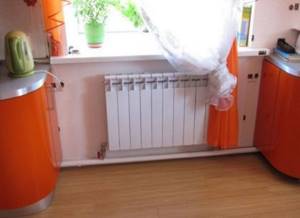
Single-pipe heating with bottom wiring
But for the low price and simplicity, you have to put up with one, but very significant drawback of such a scheme - the inability to achieve uniform heat distribution across all radiators. At the beginning of the heating pipe, the batteries will be excessively hot, and at the end, on the contrary, they will be barely warm.
Advice! If for some reason you want to install a single-pipe heating system, then you can solve the problem of uneven heat distribution as follows: from the boiler to the farthest point of the line, gradually increase the number of sections in the radiator. Due to this, the heat transfer of the system will be more uniform. The downside of this approach is the increased costs of radiators, which call into question the main advantage of single-pipe wiring - low cost.
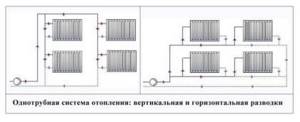
Vertical wiring of a single-pipe circuit is suitable for apartment buildings or with natural coolant circulation. For a cottage, it makes sense to give preference to a horizontal system. Often the main line is “hidden” in the wall or under the floor surface

"Leningradka" is the most advanced of single-pipe heating systems. Each radiator is connected through tees and bends and is equipped with shut-off valves. With its help, the owner of a house with a one-pipe system can disconnect a separate battery from the main without turning off the entire circuit as a whole
A more modern and advanced heating system arrangement is a two-pipe layout. Here, instead of one line, two are used - the first for supplying coolant to the radiators, the second for discharging it back to the boiler. These pipes are called “supply” and “return” respectively.

A picture illustrating the principle of operation of a two-pipe heating system
In many ways, the advantages and disadvantages of one- and two-pipe heating systems are mutually opposite. So, the advantages of the “supply” and “return” scheme include the following.
- More uniform distribution of thermal energy across radiators. With a competent approach to regulation on the supply line, all heating radiators in the cottage will have approximately the same temperature. The situation when there is boiling water in the first radiator and lukewarm water in the second does not happen here.
- Smaller diameter of pipes required for laying such a heating system.
- The ability to regulate the temperature in each individual room using a thermostat and a tap on the supply line to the battery.
A two-pipe heating system has its drawbacks, two of them - increased costs for materials and the need to spend more time and effort on installing heating. Moreover, the first drawback is considered controversial by many owners of country houses - yes, for heating with “supply” and “return” more pipes are needed, but at the same time their diameter is smaller. You will also need more compact (and therefore cheaper) fittings, connectors and shut-off valves.
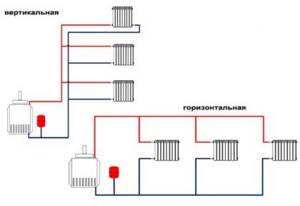
Example of vertical and horizontal heating schemes
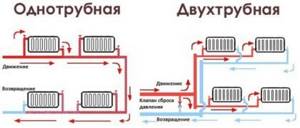
With this diagram you can easily understand the difference between one- and two-pipe water heating pipes.
Interesting! The best distribution of thermal energy between heating radiators can be achieved using radial wiring - when from the boiler to each individual radiator there are its own “supply” and “return” lines, laid under the floor surface. Such a scheme requires a lot of time and money to install, but the result will be high heating efficiency.
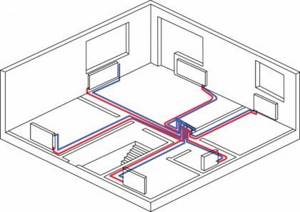
An example of a radial two-pipe heating system from a distribution manifold
Collector heating supply for a cottage
Collector heating of the cottage
How to properly install heating in a cottage if its area is equal to or exceeds 200 m². Even installing a two-pipe system in this case will be impractical. To solve this issue, it is best to use collector piping.
Currently, this is one of the most difficult ways to organize heating of a cottage with your own hands. To uniformly distribute the coolant over a large area of the building, a multipath piping scheme is used. Immediately after the boiler, the main and return collectors are installed, to which several independent lines are connected. Unlike the two-pipe heating system of a cottage, the collector system provides the ability to regulate the operation of the heat supply for each individual circuit. For this purpose, control devices are installed - thermostats and flow meters.
The features of collector heating for a do-it-yourself cottage include:
- Uniform distribution of heat over all circuits, regardless of their distance;
- Possibility of using small diameter pipes – up to 20 mm. This is due to the small length of each node of the system;
- Increased pipe consumption. In order to properly install collector heating in a cottage, it is necessary to draw up a pipeline installation diagram in advance. They can be wall or floor mounted;
- Mandatory installation of a pump for each circuit. This is due to the high hydraulic resistance that occurs in the collector. It may interfere with coolant circulation.
When choosing a ready-made heating supply project for a cottage or when drawing it up yourself, you need to take into account the heat losses of the building. The design power of the entire system will depend on them.
For two and three-story cottages with a large area, a heat supply system with several distribution manifolds is best suited.
Steam boilers
Steam heating involves the use of special boilers in which water is heated to boiling temperature, after which the resulting hot steam enters the radiators through a closed system. After heating the radiators, the steam in the form of a liquid flows back into the boiler. A steam heating system can be powered by a variety of fuels, including gas, electricity, wood and coal.
The advantages of steam heating in a private home include the following:
- resistance to coolant freezing;
- cyclical work;
- complete environmental friendliness;
- no heat loss in the heat exchanger;
- high rate of heating of the house;
- excellent economy.
Like any heating equipment, steam technology for heating a home has certain disadvantages.

friendly. These include:
- inability to adjust the heating temperature of the house;
- the appearance of metal corrosion due to exposure to steam;
- high coolant temperature reduces the service life of equipment;
- the need to install grilles on radiators.
The boilers used in water heating systems can be made in single- and double-circuit versions, respectively, such equipment allows not only to heat the house, but also solves problems with hot water supply .
By correctly selecting the power of the entire system and optimizing the use of available fuel, you can somewhat reduce the cost of heating your home in the winter.
Basic elements of a water heating system
The main elements of a water heating system include:
- boiler;
- a device that supplies air to the combustion chamber;
- equipment responsible for removing combustion products;
- pumping units that circulate coolant through the heating circuit;
- pipelines and fittings (fittings, shut-off valves, etc.);
- radiators (cast iron, steel, aluminum, etc.).
Selecting a boiler by the number of circuits
To heat the cottage, you can choose a single-circuit or double-circuit boiler. What is the difference between these models of boiler equipment? A single-circuit boiler is designed only to heat the coolant intended for circulation through the heating system. Indirect heating boilers are connected to single-circuit models, which supply the facility with hot water for technical purposes. Dual-circuit models provide for operation of the unit in two directions that do not intersect with each other. One circuit is responsible only for heating, the other for hot water supply.
Selecting a boiler by type of fuel
The most economical and convenient type of fuel for modern boilers has always been and remains main gas. The efficiency of gas boilers is not disputed, since their efficiency is 95%, and in some models this figure goes beyond 100%. We are talking about condensing units capable of “pulling” heat from combustion products, which in other models simply fly away “down the chimney”.
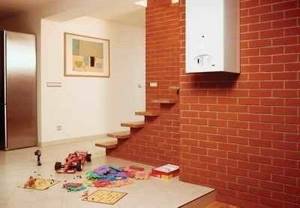
Heating a country cottage with a wall-mounted gas boiler is one of the popular methods of heating living space in gasified regions
However, not all territories are gasified, so boiler equipment that runs on solid and liquid fuels, as well as electricity, is very popular. Using electric boilers for heating a cottage is even more convenient and safer than gas, provided that the region has stable operation of electrical networks. Many owners are stopped by the cost of electricity, as well as the limited supply rate for one facility. The requirement to connect an electric boiler to a three-phase network with a voltage of 380 V is also not to everyone’s liking or affordability. Electric heating of cottages can be made more economical by using alternative sources of electricity (wind turbines, solar panels, etc.).
In cottages built in remote regions, cut off from gas and electric mains, liquid fuel boilers are installed. The fuel used in these units is diesel fuel (diesel fuel) or used oil, if there is a source of constant replenishment. Solid fuel units operating on coal, wood, peat briquettes, pellets, etc. are very common.
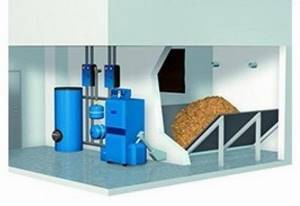
Heating a country cottage with a solid fuel boiler running on pellets - granulated wood pellets having a cylindrical shape and a certain size
Selecting a boiler by power
Having decided on the type of boiler equipment according to the fuel criterion, we begin to select a boiler of the required power. The higher this indicator, the more expensive the model, so you must not miscalculate when determining the power of the unit purchased for a particular cottage. You can’t follow the path: the less the better. Since in this case the equipment cannot fully cope with the task of heating the entire area of a country house to a comfortable temperature.
The unit’s low power will be especially noticeable on cold days, when the thermometer will show abnormally low temperatures outside the window. Therefore, it is recommended to purchase boilers with a slightly higher power than the calculations show, but not significantly higher. Why overpay money and then force the equipment to work “idle”?
Induction system
Modern and economical equipment operating on the principle of electromagnetic induction. When an electric current passes, a coil of wire forms a strong electromagnetic field and heats the ferromagnet. In the case of a heater, the coil is wound on a pipe made of a special material with a steel core. The device is connected to a system filled with coolant (water, oil, ethylene glycol), which rises when heated and starts the circuit.
In industry, steel has been melted using this method for two hundred years, that is, the principle has been known for a long time and the technology cannot be called new.
pros
- Durability. The warranty on induction heaters is 10 years or more. The absence of moving elements in the system eliminates mechanical wear.
- Scale does not form in the heating system of a private house, so an induction boiler is equally effective in the first and tenth year of operation.
- Completely silent operation. There are no pumps in the system, so the electric boiler does not make noise.
- To install an induction heater, no additional space is required, and installation can be done with your own hands.
- Rapid heating of the coolant due to the lack of insulation - the rod heats the coolant.
Minuses
- High price. Factory models are made using modern materials, and this explains the high cost. You can build an induction boiler yourself, but in terms of efficiency it will be inferior to factory samples.
- A boiler with a power of over 7 kW requires an electrical network of 380 V.
- If the water supply to the system stops, the equipment will overheat and fail. To avoid breakdowns, the system must be equipped with a pressure sensor and an automatic device shutdown.
Which heating radiators to choose
Despite the types of heating systems, in any case, special equipment is required to supply heat to the cottage: heating radiators, radiators. All heating equipment can be divided into 4 types:
1) Cast iron radiators are an excellent coolant. But they are not without the risk of water hammer, which can lead to damage when the heating season begins. Since the inner surface of the radiator is rough, it is capable of accumulating limescale deposits, which block the flow of heat into the room. When choosing a cast iron radiator for a cottage, you should take into account that a local heating system is installed.
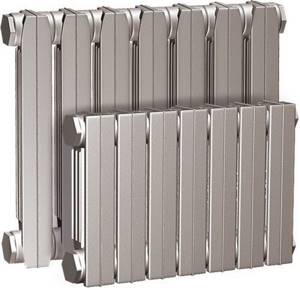
2) Steel radiators are more resistant to water hammer and do not have the disadvantages of cast iron radiators; they transfer heat better. But they are not resistant to corrosion; rust may form on the inner wall, which requires careful maintenance of the batteries, or they will require too frequent replacement.

3) Aluminum radiators have a lightweight design, conduct heat well, are resistant to corrosion, but are not able to withstand water hammer. If the cottage uses a local heating system, then such a radiator can be an excellent solution.
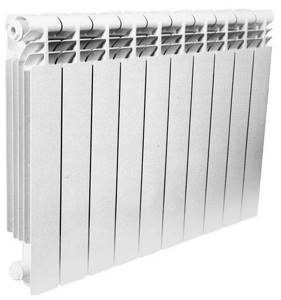
4) Bimetallic radiators are the most efficient. They are resistant to corrosion, water hammer, do not form scale on the inner surface, and give off more heat. Among the shortcomings, only the high price was identified.
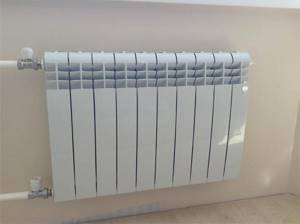
Number of radiator sections: how to correctly calculate
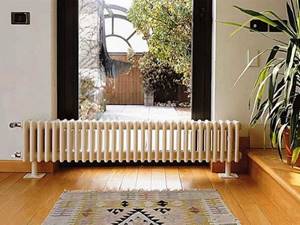
Number of battery sections: wise selection
The calculation of the heating system is carried out with the obligatory selection of the number of radiator sections. A fairly simple formula can also be used here - the area of the room that is meant to be heated must be multiplied by 100 and divided by the power of the battery section.
- Room area. As a rule, all radiators are designed to heat only one room, and therefore the total area of the house is not needed. The only exception is if next to the room that is heated there is some room that is not equipped with a heating system;
- The number 100, which appears in the formula for calculating the number of radiator sections for a heating system, is not taken out of thin air. According to SNiP requirements, about 100 W of power is used per square meter of living space. This is quite enough to maintain a comfortable temperature;
- As for the power of the heating radiator section, it is individual and depends, first of all, on the material of the batteries. If it is impossible to accurately determine the parameter, then for calculations you can take 180-200 W - this corresponds to the average power of a section of modern radiators.
Having received all the data, you can begin calculating the heating batteries. If we take as a basis the size of the room as 20 m2, and the power of the sections as 180 W, then the number of heating radiator elements can be calculated as follows:
n=20*100|180=11
Advice. As is the case with the boiler power, the number of battery sections must be taken “with a reserve”, this will allow you not to worry about severe frosts.
It should be noted that for rooms located at the end or on the corner of a building, the result obtained must be multiplied by 1.2. Thus, it will be possible to achieve the most optimal values and determine a sufficient number of radiator sections to heat a country cottage.
Heating a summer house
Imagine a classic summer house on classic six hundred square meters, which was not originally intended for year-round use.
This is precisely one of the most difficult and not at all budgetary cases. Before installing a heating system in such a house, it is necessary to insulate it so as not to heat the street. Ideally, you need to find and neutralize all the cracks in the walls, seal the openings in the windows through which cold air can penetrate and heat can escape. The floors and walls need thermal insulation, which will entail cosmetic repairs. Together with materials and the work of specialists, it will cost at least 50 thousand rubles.
How to choose heating radiators?
Oil, infrared heater, convector or fan heater?
In addition, a good heating system that does not have to be replaced in the first winter is also not cheap. Boiler, pipes, radiators - you will have to spend at least 50 thousand more on the purchase of equipment and the work of installers.
It turns out that heating a summer house costs at least 100 thousand rubles. The larger the house, the higher the costs.
Yes, it is cheaper than building a new insulated house. But if you just want to slightly extend the summer season from early May to late September, it is easier to buy a stove or an oil-fired portable radiator that runs on electricity.
And it’s best to think about heating, in an amicable way, at the stage of designing a house.
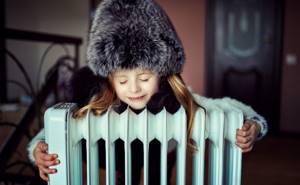
6okean.gmail.com/Depositphotos
Installation of a cottage heating system
After the boiler room has been arranged, radiators are installed according to the heating scheme of the cottage. The main parameters by which consumers choose radiators are: size, power and the material from which they are made.
Internal wiring
When installing a cottage heating system, special attention should be paid to the material of the pipes. Today, there are several types of pipes that are traditionally used in heating systems. Let's take a closer look at these types.
- Steel pipes. Durable, resistant to pressure changes, but difficult to install and susceptible to corrosion. Over the years, a layer of rust settles on the inner walls, which can impede the flow of water.
- Metal-plastic pipes. Durable, flexible and easy to install. Convenient to use with complex geometry of the heating system. But they also have a number of weak points: they are destroyed by mechanical stress and ultraviolet radiation, and are also flammable.
- Propylene pipes. The most popular material, which is undoubtedly due to the price of such pipes. They are the most economical compared to pipes of other materials. They have only one drawback - good flammability. Otherwise, it is an ideal material for heating pipes. They do not rust, do not crack, are easily welded using special “irons”, and are durable in use.
- Stainless steel pipes. They are usually used in non-residential premises: basements, laundries, billiard rooms. They have good heat transfer, so high that they can heat a room without installing radiators. A variety is corrugated stainless steel pipes. In addition to the above, they have one more advantage: they easily “go around” corners and turns without additional joints.
Crimping
Before starting the heating system, it is necessary to check all components and connections. To do this, the system is pressurized. That is, they pump air or water under pressure 2-2.5 times higher than the working pressure and leave it for a day. During this time, leaks are detected and eliminated at the junctions of system parts. For the first time, it is recommended to heat the boiler to no more than 40 C. After filling the entire system with water, each radiator is checked for warming up and the entire heating system as a whole. After checking, the heating power of the boiler can be increased.
Steam heating
The old heating method has not lost its relevance against the backdrop of innovative systems. The coolant is steam, installation of the heating system is simple. The source is a steam boiler from which heat enters the pipes and radiators of the reduction-cooling equipment or steam turbine. Cooling, the steam turns into condensate and returns back.
Theoretically, you can build steam heating with your own hands, but boilers are not installed in private homes. The boiler is very large, the steam temperature exceeds 100°C, operation requires a professional approach. Traditionally, enterprises that use steam in their production process are heated this way, and its excess is used for heating.
Reliability of operation and temperature significantly depend on the quality of the boiler in this system, so it should be selected taking into account the area and structural features. Steam boilers operate on various fuels: liquid, solid, combined, natural gas.
pros
- Relative cheapness of the boiler.
- Fast heating of the room.
- Preservation of heat in the system.
Minuses
- Cumbersomeness and danger of steam boilers if used incorrectly.
- Heating heating devices to high temperatures.
- Inability to smoothly regulate room temperature.
- Filling the system with steam is accompanied by noise.
- Complex installation of the system.
Which boiler to choose?
When it comes to choosing, you should start from 4 main options. When considering each, you need to take into account what fuel is available and cheap in a certain area.
Gas
The gas boiler is the most popular due to the availability of this fuel. If we talk about its strengths, we can note the following:
- long service life,
- high efficiency, which means cost savings,
- ease of maintenance,
- there is no need to waste energy on fuel procurement when there is access to the highway.
Now about some weaknesses:
- permission to install the boiler is required,
- to connect you need to call special services,
- due to pressure surges in the gas pipeline, the unit turns off,
- Gas makes noise when it burns.
In general, it is an economical and reliable type of heating that requires only proper installation.
Electric boiler
This device is also quite popular. Here the heating of the coolant occurs due to electricity. Since it is widely available, it is worth considering this method from different angles. Advantages of electrical equipment:
- works without noise,
- relatively low cost,
- does not harm health or the environment,
- ease of operation.
The disadvantages include:
- when voltage surges occur, the device shuts down, and the automation is also disabled,
- electricity consumption,
- for a powerful unit you need a 3-phase network of 380 V.
Such a boiler is especially suitable when the price of electricity is inexpensive.
Solid fuel boilers
Quite a well-known type of boiler. Here, coal, firewood, and so on are used as fuel. Speaking about the advantages of such equipment, you should remember the following points:
- inexpensive type of fuel,
- ease of operation,
- does not require any documents for installation,
- easy to repair.
Here are some disadvantages:
- a lot of time and effort is spent on fuel procurement and boiler maintenance,
- There must be a chimney.
This heating method is quite often used in populated areas without a gas main.
Liquid fuel boilers
Liquid fuels such as fuel oil, kerosene and so on are used here. When listing the advantages of liquid fuel equipment, the following areas should be mentioned:
- heating independent of communications,
- ease of use,
- high efficiency,
Speaking about the disadvantages, it is necessary to remember the following nuances:
- a separate room for the boiler is required,
- expensive equipment,
- high cost of fuel,
- need for large fuel tanks.
Typically, liquid fuel heating units are not often used.
Comparison of systems by energy carrier type
The most popular types of heating for a country house are:
- oven;
- gas;
- diesel;
- electrical;
- solid fuel.
Also, homeowners are increasingly interested in progressive methods of generating heat - using heat pumps and solar collectors.
Option #1 - stove heating
Although stove heating today is considered to be a relic of the past, in many cases it becomes the only possible and affordable heating option. This solution is distinguished by its relative simplicity and guaranteed absence of fuel problems. Agree, you can get firewood or wood waste almost always and everywhere.
As for the disadvantages of stove heating, this is, first of all, bulkiness. The “classic rustic” design “bites off” a decent portion of the usable living space. But without monumentality, a stove will no longer be a stove, because it is thanks to the walls of impressive thickness that the device is able to effectively accumulate heat to maintain a comfortable temperature in the house.

The stove, despite its impressive size, is a good source of heat in the house and a worthy decoration for a classic interior.
The walls of the stove take a long time to heat up and take a long time to cool down, which means that it will not be possible to quickly change the temperature in the home, especially upward, even if you want to. When installing stove heating in your home, you should be prepared for the fact that you will always have to languish in anticipation of the “first portion” of heat.
A working stove requires constant “monitoring” due to the risk of backdraft and burns for children. The operation of the structure cannot be automated in any way, which does not add any pleasure to its operation.
As practice shows, if there is a real opportunity and desire to install a more practical and efficient system, it is better to abandon stove heating.
Option #2 - gas heating
One of the most convenient and cost-effective ways to heat a country house is a heating system based on a gas boiler. Naturally, if main gas is connected to the house. Otherwise, an attempt to arrange gas heating can hit your pocket so hard that there will be no talk of any payback for the system.
Gasification of a residential property is a procedure that requires not only enormous financial, but also time costs. Collecting all the necessary documents can take months. Of course, you can relieve yourself of the headache of paperwork by contacting a special service, but then the already considerable amount for gasification is guaranteed to double - such offices do not work for a “thank you”. And this is just a tap into the pipe. And if you take into account the cost of a decent boiler and all other elements of the heating system, then it is obvious that the idea of gas heating threatens the homeowner with complete bankruptcy.
As an option, you can resort to autonomous gasification - install an underground gas holder to store imported gas or use cylinders. But such a pleasure cannot be called budget-friendly.
Note! Operating a gas tank if its installation is not of sufficient quality is extremely dangerous and harmful: damage to the tank can cause a gas leak.
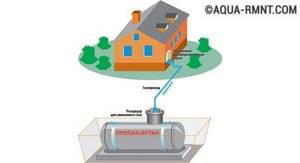
Increasing the level of safety of the heating system of a country house based on a gas holder and regulating the pressure in it is facilitated by the installation of a control and distribution point (KRP)
For the lucky owners of country houses connected to a gas pipeline, heating their home with a gas boiler is a wise decision, since this equipment has many advantages, in particular, environmental friendliness, economy and high efficiency.
The main disadvantage of any heating system that draws thermal energy from natural gas is the high risk of explosion and fire. Natural gas is easily ignited by any spark, even with the slightest leak. Therefore, the installation of a gas boiler and all necessary commissioning work must be carried out exclusively by authorized persons in order to avoid unfortunate incidents. Periodic maintenance of equipment is mandatory. And you shouldn’t perceive such “professional examinations” as a money grab – thanks to them, you can prevent a lot of problems.
Option #3 - heating with diesel fuel
Heating a country house with diesel fuel is a fairly common practice for many, including highly developed countries. This solution, according to experts, is an excellent alternative to gas heating. True, you can only consider it if you have a considerable budget. The diesel boiler itself is quite expensive, and this is just the tip of the iceberg: you still need to equip the boiler room, resolve the issue of fuel storage, install the system, and organize a good ventilation system. As a result, a tidy sum accumulates. But if there is no way to connect to the gas mains, and the house really needs constant high-quality heating and the funds allow, then diesel heating is really a good option. It is effective and safe.
A house served by a diesel installation can be safely left unattended for a long time; It is enough to visit the boiler room itself once a quarter.
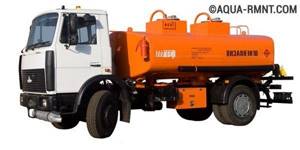
In order for an oil-fuel boiler to work “like a clock,” diesel fuel must be of exceptional quality. Therefore, it is recommended to purchase it only from trusted suppliers.
Problems with fuel usually do not arise - diesel fuel can be delivered even to a populated area remote from civilization. But it is better to choose tanks for diesel fuel that are as large as possible - they will have to be filled less often.
Option #4 - electric heating system
If you are looking for the simplest way to heat a country house, you can turn your attention to electric heating. It does not require large initial financial investments, is environmentally friendly, silent, easy to operate, and does not require special maintenance. But this is on the one hand. On the other hand, it cannot be called economical, and this option is not suitable for every building. Housing with an area of more than 100 sq. m constantly heating with electricity is not profitable, and a house with insufficient wiring power is unsafe.
And heating with electricity is the most expensive heating method of all existing ones. Therefore, it should still be considered either as an additional measure or as a compromise solution for occasional use (for example, if you visit your “country estates” infrequently).
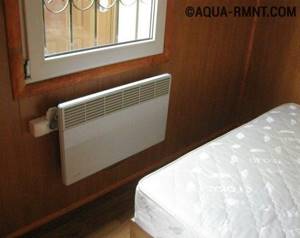
You can organize additional heating in a country house using electric convectors - compact, reliable and easy-to-maintain devices
For the main heating of a permanent residence, electric heating is a completely impractical choice. The minimal cost of installing a heating system based on an electric boiler is a very dubious benefit against the backdrop of fabulous operational waste.
Option #5 - solid fuel boiler
If electricity is considered the most expensive source of heat, then, of course, there is one that can be called the cheapest. And this is solid fuel. No, you don’t need to imagine the stoves right away. After all, they exist - solid fuel boilers, which allow you to significantly save on heating and at the same time not feel like you are in the “Stone Age”.
Modern solid fuel heating equipment has good efficiency, safety, environmental friendliness and durability. These units are characterized by a “reasonable” cost, which makes them an affordable solution for any person with average income.
Yes, most solid fuel boilers require manual loading of fuel (firewood, wood waste, eurowood, coal, peat briquettes), but this in no way detracts from their advantages:
- opportunities to obtain heat thanks to environmentally friendly renewable resources;
- minimal operating costs;
- extremely rare need for repair or replacement of system elements.
If the need to frequently service a solid fuel boiler (depending on the type of unit - up to several times a day) does not scare you, you can safely equip a heating system in a country house based on it.
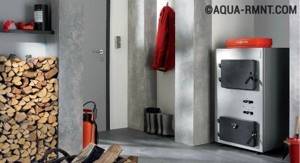
Depending on the type of fuel used, solid fuel boilers are coal-fired, wood-fired, pellet, and multi-fuel.
Separately, it is worth mentioning such a relatively new type of solid fuel heating equipment as pellet boilers. Their main advantage over their “brothers” is maximum automation of the work process. Pellet boilers have the ability to program operating modes and maintain a given temperature.
Such units are equipped with a special pellet burner, which provides higher efficiency than other solid fuel boilers; they are comparable in efficiency to devices running on natural gas. Fuel supply from the operational bunker is carried out automatically. As long as there are pellets in the bunker, the pellet boiler can operate quietly without human intervention (usually up to a week).
The heating system of a country house with wood pellets guarantees complete explosion and fire safety. It does not require any professional special maintenance (as is the case with gas installations). This is a great choice in many ways.
Interesting! If desired, you can modify a regular universal solid fuel boiler for pellets. True, its effectiveness will not be as high as that of the “original”.
Option #6 - alternative energy sources
We live in a time when the use of natural energy sources - the sun, earth, air and water - no longer seems exotic. Traditional types of fuel are inexorably becoming more expensive, and this, willy-nilly, prompts us to pay attention to alternative solutions for organizing heating. In particular, for solar collectors and heat pumps. True, such developments are only affordable for very wealthy people. Heating and hot water system for a country house with an area of about 150 square meters. m based on an alternative source will cost the owner at least 600 thousand rubles. In addition, given our harsh climate and other realities, we must objectively admit that it is impossible to use either heat pumps or solar collectors as the main (and only) source of heat.
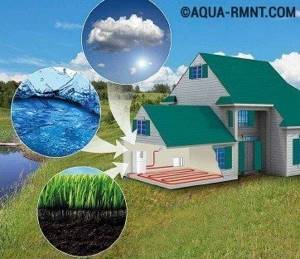
Heat pumps are progressive devices that allow the use of thermal energy from air, water and soil for heating and air conditioning a house and preparing hot water.
You can try to “touch progress” only if you are also ready to spend money on one of the traditional types of heating. By the way, one can ultimately derive considerable benefits from the harmonious “tandem” of alternative and traditional energy sources. But the initial investments in a “promising future” are required to be colossal.
What is included in a professionally designed heating system project?
When ordering a project from the company’s specialized specialists, the customer should receive:
- Title page with the original seal of the organization.
- Explanatory note (mandatory) to the created project.
- Communications layout plan (general).
- Elevation plan of the same wiring.
- Estimate: for the project, materials, types of work and their cost.
- Specification of materials and special equipment.
- The project is in the form of a detailed sketch.
- A drawing with precise detail and dimensions of all main and additional components.
- Utility wiring plan, connection points and tie-ins.
Before creating a project, an engineer must arrive on site to take the necessary measurements and draw up a preliminary drawing. After which a contract is drawn up with the customer, all possible options are considered, taking into account the client’s preferences and wishes. Each customer has the right to demand from the design company a copy of the project in electronic form or request a copy of it in paper form.
Evolution of traditional systems and boilers
In Soviet times, when no one was concerned about the cost of energy, heating equipment and systems were quite primitive, although they were made very reliably and lasted for many years. Now priorities have changed, modern energy-saving technologies have become relevant, allowing us to save constantly rising energy prices.
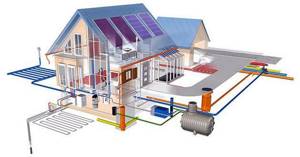
Thanks to this, traditional systems have become more perfect through the introduction of such solutions:
- increasing the efficiency of all boiler installations, excluding electric ones, since their efficiency is already very high (98-99%);
- the use of new materials and technologies for the manufacture of heating radiators;
- introduction of modern automation equipment that controls the operation of systems depending on weather conditions and time of day, including remotely;
- the use of low-temperature heating networks - water-heated floors with automatic heating control;
- implementation of heat recovery from exhaust air during air heating of buildings (recovery).
A striking example of energy-saving gas equipment are condensing boilers, where the most modern heat exchangers are installed. The fact is that when methane burns, water is formed, which immediately evaporates in the burner flame and thus takes away part of the heat generated. The heat exchanger of a condensing boiler is designed to cause vapor to condense and release this energy back. Due to this innovative solution, the efficiency of the heat generator reaches 96%.

Burner devices have also undergone changes; now they can independently dose the amount of fuel and air, as well as automatically change the combustion intensity. This also applies to solid fuel boilers that burn wood pellets. Thanks to the purity of this type of solid fuel, complete automation of the process and developed heat exchange surface, a modern pellet boiler can operate with an efficiency of up to 85%.
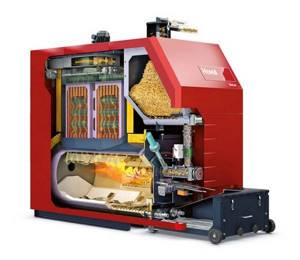
Increasing the efficiency of conventional wood-burning boilers for heating private houses can only be achieved by extracting heat from flue gases; the average figure for these units is 70-75%.
Modern heating devices are made from the best heat-conducting materials - aluminum alloy and steel, although retro-style cast iron batteries still have many fans. A real novelty in the field of heating are water baseboard convectors, made of copper plates and very efficiently transferring heat to the premises of a private house.
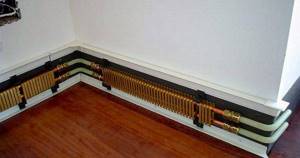
Types of pipe routing
Much depends on a well-chosen wiring. There are 3 options: single-pipe, two-pipe and manifold. It is necessary to understand each method in detail in order to determine which one is better in a particular case.
Single pipe system
Its essence is that all radiators are connected in series to one pipe. Thus, before reaching the last battery, the coolant must heat all the previous ones.
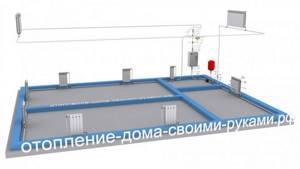
single pipe heating
It is worth looking at the advantages and disadvantages of a single-pipe system.
As always, first the advantages:
- it is easy to design such a system,
- easy installation,
- relatively low equipment costs,
- quick installation compared to other options.
However, one must also see the disadvantages:
- uneven heating of all rooms - the first is hot, and the last is cool,
- elements are highly dependent on each other,
- inefficiency of a large number of radiators on one riser,
- The heat in each battery is not regulated.
As you can see, this option is economical in terms of installation and is suitable for a room with a small area.
Two-pipe system
This method differs from the first in that 2 pipes are connected to each radiator. Through one of them the heated coolant flows, and through the other, the cooled coolant returns back to the boiler.
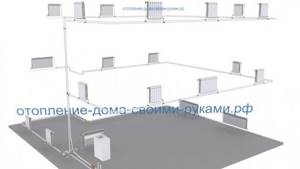
two-pipe heating
Here you should also pay attention to the advantages and disadvantages of the system.
The advantages are:
- when it becomes necessary to temporarily suspend the operation of one element of the system (for example, a radiator), then the rest of the line will be able to continue to function,
- both the first and last radiators heat up equally, which allows the entire room to be heated evenly,
- The temperature in each room is conveniently regulated.
Such efficiency of the system complicates some aspects of its organization:
- more difficult to install,
- It is not easy to design such a system yourself,
- equipment costs more.
To summarize, it becomes clear that this wiring method is more convenient to use, economical and effective. Although installation will cost more than a single-pipe system.
Collector wiring
The collector looks like a comb to which various heating equipment is connected. From the boiler, the heated coolant is supplied to the collector. It distributes the coolant to different heating devices separately. Thus, liquid of the same temperature is supplied to each radiator.
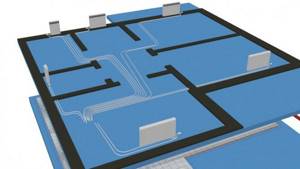
collector heating
In this option, it is also necessary to carefully consider the advantages and disadvantages.
If we talk about the advantages, they include the following points:
- If you do everything according to the instructions, the installation is quite simple,
- thanks to the manifold, each heating device is regulated and turned off individually,
- the number of pipe joints is significantly reduced, which eliminates the possibility of leakage,
- convenient repair of each element of the system.
The only thing that can be attributed to the disadvantages of such wiring is the cost of the equipment. However, the convenience and savings that this system provides will quickly pay for all the investment.
